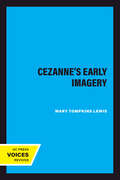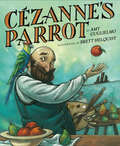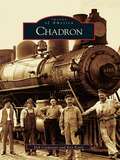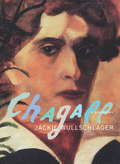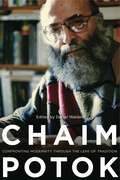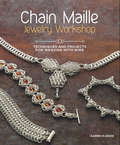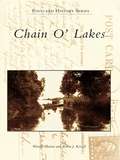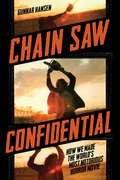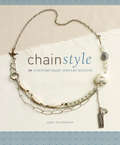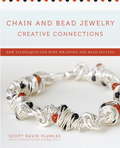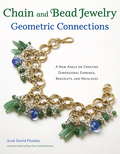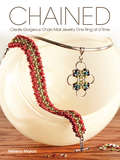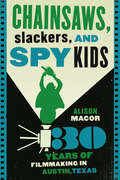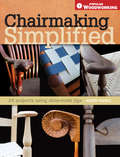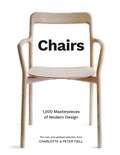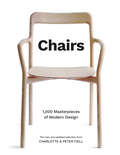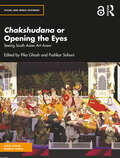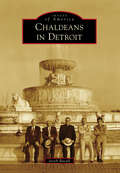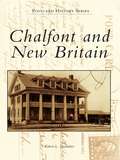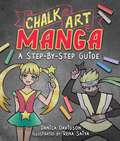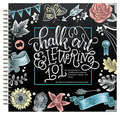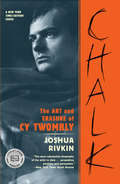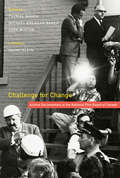- Table View
- List View
Cezanne's Early Imagery
by Mary Tompkins LewisThis title is part of UC Press's Voices Revived program, which commemorates University of California Press’s mission to seek out and cultivate the brightest minds and give them voice, reach, and impact. Drawing on a backlist dating to 1893, Voices Revived makes high-quality, peer-reviewed scholarship accessible once again using print-on-demand technology. This title was originally published in 1989.
Cezanne's Parrot
by Amy GuglielmoAn inspiring picture book biography of the artist Paul Cezanne, the painter who laid the groundwork for modern art and whom Pablo Picasso declared "the father of us all."All Cezanne wants is to be a great painter like his friends Monet, Pissarro, and Renoir. But when he shows his works, the professors, the critics, and the collectors all dismiss him: "Too flat!" "Too much paint!" "These are rough and unfinished!" Even his own pet parrot, Bisou, can't be brought to say, "Cezanne is a great painter!" And who can blame them? Cezanne doesn't care about tradition, and he doesn't follow the rules. He's painting in a way no one else has done before, creating something completely new--and he's destined to change the world of art forever. Cezanne's Parrot is a spirited celebration of creativity, determination, and perseverance--and the artist who would become known as the father of modern art.
Chadron
by Ken Korte Deb CarpenterOver 150 years ago, the area now known as Chadron was vast, open grassland. Nearby water sources, Chartran Creek and Bordeaux Creek, were named for the French fur traders whose main customers were nomadic tribes the French called the Sioux. When gold was discovered in the Black Hills, the area quickly changed. The military outposts Fort Robinson and Camp Sheridan were established to control Indian Agencies for Red Cloud's and Spotted Tail's bands. Cattle replaced buffalo on the rich grasslands. The railroad pushed its way west, and the rest, as they say, is history.
Chagall
by Jackie Wullschlager“When Matisse dies,” Pablo Picasso remarked in the 1950s, “Chagall will be the only painter left who understands what color really is. ” As a pioneer of modernism and one of the greatest figurative artists of the twentieth century, Marc Chagall achieved fame and fortune, and over the course of a long career created some of the best-known and most-loved paintings of our time. Yet behind this triumph lay struggle, heartbreak, bitterness, frustration, lost love, exile—and above all the miracle of survival. Born into near poverty in Russia in 1887, the son of a Jewish herring merchant, Chagall fled the repressive “potato-colored” tsarist empire in 1911 for Paris. There he worked alongside Modigliani and Léger in the tumbledown tenement called La Ruche, where “one either died or came out famous. ” But turmoil lay ahead—war and revolution; a period as an improbable artistic commissar in the young Soviet Union; a difficult existence in Weimar Germany, occupied France, and eventually the United States. Throughout, as Jackie Wullschlager makes plain in this groundbreaking biography, he never ceased giving form on canvas to his dreams, longings, and memories. His subject, more often than not, was the shtetl life of his childhood, the wooden huts and synagogues, the goatherds, rabbis, and violinists—the whole lost world of Eastern European Jewry. Wullschlager brilliantly describes this world and evokes the characters who peopled it: Chagall’s passionate, energetic mother, Feiga-Ita; his eccentric fellow painter and teacher Bakst; his clever, intense first wife, Bella; their glamorous daughter, Ida; his tough-minded final companion and wife, Vava; and the colorful, tragic array of artist, actor, and writer friends who perished under the Stalinist regime. Wullschlager explores in detail Chagall’s complex relationship with Russia and makes clear the Russian dimension he brought to Western modernism. She shows how, as André Breton put it, “under his sole impulse, metaphor made its triumphal entry into modern painting,” and helped shape the new surrealist movement. As art critic of theFinancial Times,she provides a breadth of knowledge on Chagall’s work, and at the same time as an experienced biographer she brings Chagall the man fully to life—ambitious, charming, suspicious, funny, contradictory, dependent, but above all obsessively determined to produce art of singular beauty and emotional depth. Drawing upon hitherto unseen archival material, including numerous letters from the family collection in Paris, and illustrated with nearly two hundred paintings, drawings, and photographs,Chagallis a landmark biography to rank with Hilary Spurling’sMatisseand John Richardson’sPicasso.
Chaim Potok: Confronting Modernity Through the Lens of Tradition
by Daniel WaldenChaim Potok was a world-class writer and scholar, a Conservative Jew who wrote from and about his tradition and the conflicts between observance and acculturation. With a plain, straightforward style, his novels were set against the moral, spiritual, and intellectual currents of the twentieth century. This collection aims to widen the lens through which we read Chaim Potok and to establish him as an authentic American writer who created unforgettable characters forging American identities for themselves while retaining their Jewish nature. The essays illuminate the central struggle in Potok’s novels, which results from a profound desire to reconcile the appeal of modernity with the pull of traditional Judaism. The volume includes a memoir by Adena Potok and ends with Chaim Potok’s “My Life as a Writer,” a speech he gave at Penn State in 1982.Aside from the editor, the contributors are Victoria Aarons, Nathan P. Devir, Jane Eisner, Susanne Klingenstein, S. Lillian Kremer, Jessica Lang, Sanford E. Marovitz, Kathryn McClymond, Hugh Nissenson, Adena Potok, and Jonathan Rosen.
Chaim Potok: Confronting Modernity Through the Lens of Tradition
by Daniel WaldenChaim Potok was a world-class writer and scholar, a Conservative Jew who wrote from and about his tradition and the conflicts between observance and acculturation. With a plain, straightforward style, his novels were set against the moral, spiritual, and intellectual currents of the twentieth century. This collection aims to widen the lens through which we read Chaim Potok and to establish him as an authentic American writer who created unforgettable characters forging American identities for themselves while retaining their Jewish nature. The essays illuminate the central struggle in Potok’s novels, which results from a profound desire to reconcile the appeal of modernity with the pull of traditional Judaism. The volume includes a memoir by Adena Potok and ends with Chaim Potok’s “My Life as a Writer,” a speech he gave at Penn State in 1982.Aside from the editor, the contributors are Victoria Aarons, Nathan P. Devir, Jane Eisner, Susanne Klingenstein, S. Lillian Kremer, Jessica Lang, Sanford E. Marovitz, Kathryn McClymond, Hugh Nissenson, Adena Potok, and Jonathan Rosen.
Chain Maille Jewelry Workshop: Techniques and Projects for Weaving with Wire
by Karen KaronDiscover the ultimate technique-based guide for one of the top trends in jewelry making--chain maille. In Chain Maille Jewelry Workshop, you'll find more than two dozen techniques for making today's most popular chain maille weaves--from simple chains to beaded wonders to intricate Dragonscale.Jewelry artist and author Karen Karon pairs in-depth, step-by-step instructions with color illustrations that show exactly where to place the next jump ring. You'll also get a thorough but flexible approach to techniques that prove weaving can be done in a multitude of ways and demonstrations on "speed weaving," which is ideal for large projects. Designs progressively increase in complexity, so every jewelry maker--beginner or pro--will find inspiration and projects that suite their skill level.What's more to love? Every chapter provides a unique jewelry project and a plethora of design advice, visual inspiration, shortcuts, tips, and tricks, as well as guidance for attaching clasps and findings. It's no wonder that Chain Maille Jewelry Workshop is the ideal resource for innovation and originality in chain maille jewelry making.
Chain O' Lakes (Postcard History)
by Wendy Maston Robin J. KessellThe Chain O' Lakes region has been one of Chicago's premier vacation spots since the 1880s. The nine major lake basins--Catherine, Channel, Grass, Bluff, Marie, Fox, Nippersink, Petite, and Pistakee--are all connected by the Fox River waterway and have for over 100 years been northern Illinois's leading destination for inland boaters, fishermen, picnickers, or those just hoping to relax and play at the beach. Luxurious mansions and swank resorts once dotted the more than 6,000 acres of shoreline. Many are gone today; some remain but have been vastly changed, but none are forgotten. Captured here in over 200 vintage postcards are scenes from the chain's heyday, scenes that will seem at once faraway and familiar to the water-skiers, windsurfers, and other outdoor recreationists who populate the Chain O' Lakes today.
Chain Saw Confidential
by Gunnar HansenWhen The Texas Chain Saw Massacre first hit movie screens in 1974 it was both reviled and championed. To critics, it was either "a degrading, senseless misuse of film and time" or "an intelligent, absorbing and deeply disturbing horror film." However it was an immediate hit with audiences. Banned and celebrated, showcased at the Cannes film festival and included in the New York MoMA's collection, it has now come to be recognized widely as one of the greatest horror movies of all time.A six-foot-four poet fresh out of grad school with limited acting experience, Gunnar Hansen played the masked, chain-saw-wielding Leatherface. His terrifying portrayal and the inventive work of the cast and crew would give the film the authentic power of nightmare, even while the gritty, grueling, and often dangerous independent production would test everyone involved, and lay the foundations for myths surrounding the film that endure even today.Critically-acclaimed author Hansen here tells the real story of the making of the film, its release, and reception, offering unknown behind-the-scenes details, a harrowingly entertaining account of the adventures of low-budget filmmaking, illuminating insights on the film's enduring and influential place in the horror genre and our culture, and a thoughtful meditation on why we love to be scared in the first place.
Chain Style: 5 Contemporary Jewelry Designs
by Jane DickersonPopular beading magazines are featuring projects incorporating chain, and the designs range from classic to vintage to steampunk. Chain Style expands on this hot trend by offering 50 creative ideas for how to use chain as the key design feature.Key Features:Learn how to stretch your beading materials by incorporating chain in your design.The tools and materials are easy to obtain, and the techniques used are suitable for beginners.Techniques include opening and closing jump rings, cutting chain, oxidizing and hammering the chain to create texture and variety plus creating wire-wrapped loops and jump rings.50 designs by top jewelry artists including Jane Dickerson, Kerry Bogert, Denise Peck, Yvonne Irvin, Leslie Rogalski, Lorelei.Jane Dickerson, editor of Step by Step and Creative Jewelry magazines, offers a step-by-step guide to making easy, stylish, and contemporary bracelets and necklaces incorporating chain as a key element of the design. With 50 fabulous projects, there is a wide variety of design styles to choose from, plus lots or inspiring ideas for using chain creatively.Designing with chain is fast, fun, and affordable . . . A few special beads connected together with chain will make a fabulous necklace in minutes!
Chain and Bead Jewelry Creative Connections: New Techniques for Wire-Wrapping and Bead-Setting
by Scott David PlumleeFar from its original utilitarian use—to create armor—the chain-mail technique has been adapted over time to create beautiful, unique jewelry. InChain and Bead Jewelry Creative Connections,chain-mail expert Scott David Plumleeshows jewelry makers, beaders, and crafters at all skill levels how to incorporate beads into a variety of chain-mail weaves to create showstopping pieces. First, Plumlee walks readers through basic skills and provides detailed information on traditional chain designs. He then presents more than 20 wire-wrapping and bead-setting techniques that incorporate beads seamlessly into a variety of designs, from the creative “Chaos” wire-wrapped bead to the sinuous Snake. With step-by-step instructions for assembling age-old chain patterns—from simple to complex—and gorgeous designs that can be executed using only simple hand tools,Chain and Bead Jewelry Creative Connectionsis sure to inspire jewelry artisans at all levels to expand the creative possibilities of their work. From the Trade Paperback edition.
Chain and Bead Jewelry Geometric Connections
by Scott David PlumleeIn Chain and Bead Jewelry Geometric Connections, wirework jewelry designer Scott David Plumlee shares his techniques for creating an amazing array of original designs using copper, silver, brass, and gold jump rings, all inspired by geometric shapes. By adapting and building on the traditional Byzantine chain configuration, Scott creates unique collections of earrings, bracelets and necklaces, from three-sided Tripoli to the four-sided Quatrefoil to the five-sided Pentagon, plus innovative Organic designs, including fish, five- and six- pointed snowflakes, and a butterfly. The thorough "Chain and Bead Basics" chapter, which guides readers through all the essential tools and techniques, makes it easy for beginners to re-create these stunning pieces.From the Trade Paperback edition.
Chained: Create Gorgeous Chain Mail Jewelry One Ring at a Time
by Rebeca MojicaUnchain your creativity! Whether you are new to chain mail or a seasoned weaver, Chained will introduce you to the art of combining metal jump rings into intricate designs, in a new way. No other book shows how to use so many weaves in so many ways, or gives this ancient art such a beautiful and modern twist. Techniques once used for armor now have a new life and can be used to create elegant adornments. Open Chained and find: Clear, detailed step-by-step photos that will take you from opening and closing jump rings to finishing your first (or fiftieth!) project Easy-to-navigate "Weave in a Nutshell" options for many weaves that will show advanced chain mail weavers the weave of a project in just a few steps 22 beautiful projects plus dozens of variations, including earrings, bracelets, necklaces and pendants, each with its own skill level and time investment rating Endless options: choose your favorite colors, your favorite metals, customize the size of your project, and find inspiration to add your own unique stamp to any piece of chain mail jewelry Gather your pliers and piles of jump rings and weave your way to beautiful jewelry with Chained.
Chainsaws, Slackers, and Spy Kids: 30 Years of Filmmaking in Austin, Texas
by Alison MacorDuring the 1990s, Austin achieved "overnight" success and celebrity as a vital place for independent filmmaking. Directors Richard Linklater and Robert Rodriguez proved that locally made films with regional themes such as Slacker and El Mariachi could capture a national audience. Their success helped transform Austin's homegrown film community into a professional film industry staffed with talented, experienced filmmakers and equipped with state-of-the art-production facilities. Today, Austin struggles to balance the growth and expansion of its film community with an ongoing commitment to nurture the next generation of independent filmmakers. Chainsaws, Slackers, and Spy Kids chronicles the evolution of this struggle by re-creating Austin's colorful movie history. Based on revealing interviews with Richard Linklater, Robert Rodriguez, Mike Judge, Quentin Tarantino, Matthew McConaughey, George Lucas, and more than one hundred other players in the local and national film industries, Alison Macor explores how Austin has become a proving ground for contemporary independent cinema. She begins in the early 1970s with Tobe Hooper's horror classic, The Texas Chainsaw Massacre, and follows the development of the Austin film scene through 2001 with the production and release of Rodriguez's $100-million blockbuster, Spy Kids. Each chapter explores the behind-the-scenes story of a specific movie, such as Linklater's Dazed and Confused and Judge's Office Space, against the backdrop of Austin's ever-expanding film community.
Chairmaking Simplified: 24 Projects Using Shop-Made Jigs
by Kerry PierceThe fear of chairmaking is gone! Worried that you don't have what it takes to create stunning and comfortable chairs? From getting the perfect angle to making sure the size is just right and that each chair is comfortable#151;chairmaking can be a daunting task for any woodworker. But, never fear! Author Kerry Pierce draws upon decades of professional chairmaking experience to provide a handful of simple jigs that take the fear out of chairmaking. This book shows you how to make a variety of styles and types of chairs, from a ladder-back Shaker chair to a continuous-arm Windsor chair. You'll learn how to weave tape and rush seats, carve and shape wooden seats and much more.
Chairs: 1,000 Masterpieces of Modern Design, 1800 to the Present Day
by Peter Fiell Charlotte FiellFrom Alvar Aalto to Marco Zanuso, Chairs introduces over 1,000 groundbreaking innovations by the world's greatest designers. Tracing the history of the modern chair from 1800 to the present day, revered experts Charlotte and Peter Fiell comprehensively guide you through the fascinating world of seating design – from the functional office chair to the limited edition art piece.With more than 1,000 exquisite images alongside fascinating insights into the conception, design and production of these masterpieces, this definitive collection includes design classics such as Josef Hoffmann's Sitzmaschine, Robin Day's Polyprop and computer-generated masterworks by Zhang Zhoujie, amongst many more.
Chairs: 1,000 Masterpieces of Modern Design, 1800 to the Present Day
by Peter Fiell Charlotte FiellThis updated edition features designs from 1800 up to present day, and features the biggest names in furniture design, art, architecture and craft.
Chairs: 1,000 Masterpieces of Modern Design, 1800 to the Present Day
by Peter Fiell Charlotte FiellThis updated edition features designs from 1800 up to present day, and features the biggest names in furniture design, art, architecture and craft.
Chakshudana or Opening the Eyes: Seeing South Asian Art Anew (Visual and Media Histories)
by Pika Ghosh Pushkar SohoniChakshudana or rituals of opening the eyes are practiced across multiple South Asian communities by artists, sculptors, and priests. The ritual offers gods access to the mortal world. This practice, applied to the study of material and visual culture, offers a distinctive perspective to interrogate the complex engagements with paintings, sculptures, found objects, fragments, built environments, and ecologies. This volume takes the process of seeing as its focus—to look closely, remaining true to the object, but also to see widely—from multiple subjective stances and diverse bodily engagements such as walking to dreaming, glancing to looking askance, hypnotic stares, and to see beyond the visible. It examines art history through nuanced considerations of materiality, aesthetics, and regional specificities. The essays emerge from current research that builds on the contributions of Michael W. Meister, W. Norman Brown Distinguished Professor of History of Art and South Asia Studies at the University of Pennsylvania, whose works laid the foundations for the study of South Asian visual and material culture. The essays in this book underscore methodological resonances rather than privileging conventional categories of media or chronology, exploring artistic media including temples and paintings as well as Bengali-quilted textiles, manuscript ‘lozenges,’ and metal repousse. This volume, part of the Visual Media and Histories Series, will be of interest to students and researchers of history of art, religious studies, and history as well as the allied disciplines of anthropology and folklore studies. Chapter 2 of this book is freely available as a downloadable Open Access PDF at http://www.taylorfrancis.com under a Creative Commons (CC-BY-NC-ND) 4.0 license.
Chaldeans in Detroit
by Jacob BacallChaldeans (pronounced Kal-de'an) are a distinct ethnic group from present-day Iraq with roots stretching back to Abraham, the biblical patriarch of Judaism, Christianity, and Islam who was from the "Ur of the Chaldees." Chaldeans are Catholic, with their own patriarch, and they speak a dialect of Aramaic, the language of Jesus Christ. Chaldeans began immigrating to the United States at the beginning of the 20th century, when Iraq was known as Mesopotamia (the Greek word meaning "land between two rivers," the Tigris and the Euphrates). Lured by Henry Ford's promise of $5 per day, many Chaldeans went to work in Detroit's automotive factories. They soon followed their entrepreneurial instincts to open their own businesses, typically grocery markets and corner stores. Religious persecution has caused tens of thousands of Chaldeans to relocate to Michigan. Today, the Greater Detroit area has the largest concentration of Chaldeans outside of Iraq: 150,000 people.
Chalfont and New Britain
by Robert L. ShowalterNew Britain Township, founded in 1723, was a rural farming community originally settled by Welsh Baptists and German Mennonites. This changed dramatically in 1856 when the North Pennsylvania Railroad was built. Two train stations were built in the township and were named Chalfont and New Britain. The villages next to these stations attracted numerous new residents and businesses. The local picnic grove was even converted into an amusement park, which became known as Forest Park. The villages surrounding these railroad stations grew until residents decided to create their own separate boroughs, establishing Chalfont Borough in 1901 and New Britain Borough in 1928. The postcards and pictures in Chalfont and New Britain include images of the villages of Chalfont, New Britain, Line Lexington, and New Galena, as well as scenes of historic homes, hotels, stores, churches, schools, and the businesses and people who lived and worked in the community.
Chalk Art Manga: A Step-by-Step Guide
by Danica DavidsonTwo favorite art forms are together at last! Chalk art is beloved by both kids and adults, and manga is a worldwide comic book phenomenon coming from Japan. As the first book of its kind, Chalk Art Manga not only reveals the secrets to creating cute and fun manga characters in chalk, but it also shows you everything step-by-step to make it extra easy. Characters can leap out of the pages of manga and come to life under your own fingers as you draw kawaii foods that look too adorable to eat, colorful chibi people, exciting animals and monsters, and more. Just like that, your driveway, sidewalk, or chalkboard can become a canvas for vibrant and exciting manga artwork as you learn to draw, pick colors, and smudge for effect. Created by two manga experts, author/journalist Danica Davidson and manga creator/artist Rena Saiya, Chalk Art Manga is fun for the whole family.
Chalk Art and Lettering 101: An Introduction to Chalkboard Lettering, Illustration, Design, and More
by Amanda Arneill Shannon RobertsDiscover your inner chalk artist! Chalk art and lettering are all around: on menu boards at a favorite local coffee shop, brightening sidewalk easels at street fairs, and in lively artwork found in the home. Chalk art and lettering pros Amanda Arneill and Shannon Roberts have teamed up to provide friendly, step-by-step instruction in chalk lettering and art, teaching you all you need to know to create your own chalk masterpieces: Getting started– the basics of making and seasoning your own chalkboards Lettering– various alphabets and lettering stylesIllustration– steps and processes in chalk art, including banners, flowers and more Design– brings lettering and art techniques together with guided chalk projects ideas Are you ready to take your chalk skills to the next level?!
Chalk: The Art and Erasure of Cy Twombly
by Joshua RivkinThe first book to explore the life and work of painter Cy Twombly, one of the most important and influential artists of the Twentieth CenturyCy Twombly was a man obsessed with myth and history—including his own. Shuttling between stunning homes in Italy and the United States where he perfected his room-size canvases, he managed his public image carefully and rarely gave interviews. Upon first seeing Twombly’s remarkable paintings, writer Joshua Rivkin became obsessed himself with the mysterious artist, and began chasing every lead, big or small—anything that might illuminate those works, or who Twombly really was. Now, after unprecedented archival research and years of interviews, Rivkin has reconstructed Twombly’s life, from his time at the legendary Black Mountain College to his canonization in a 1994 MoMA retrospective; from his heady explorations of Rome in the 1950s with Robert Rauschenberg to the ongoing efforts to shape his legacy after his death.Including previously unpublished photographs, Chalk presents a more personal and searching type of biography than we’ve ever encountered, and brings to life a more complex Twombly than we’ve ever known.
Challenge for Change
by Michael Brendan Baker Ezra Winton Thomas WaughPioneering participatory, social change-oriented media, the program had a national and international impact on documentary film-making, yet this is the first comprehensive history and analysis of its work. The volume's contributors study dozens of films produced by the program, their themes, aesthetics, and politics, and evaluate their legacy and the program's place in Canadian, Québécois, and world cinema. An informative and nuanced look at a cinematic movement, Challenge for Change reemphasizes not just the importance of the NFB and its programs but also the role documentaries can play in improving the world.
